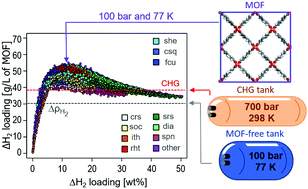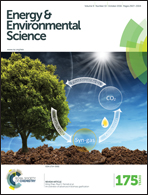Evaluating topologically diverse metal–organic frameworks for cryo-adsorbed hydrogen storage†
Abstract
Metal–organic frameworks (MOFs) are porous materials synthesized by combining inorganic and organic molecular building blocks into crystalline networks of distinct topologies. Due to the combinatorial possibilities, there are millions of possible MOF structures. Aiming to exploit their exceptional tunability, surface areas and pore volumes, researchers have investigated MOFs for storage of gaseous fuels such as hydrogen for over a decade, but a suitable MOF to store hydrogen at ambient conditions has not yet been found. Here, we sought to rapidly determine the viability of using MOFs for hydrogen storage at recently proposed, cryogenic operating conditions. We constructed a large and structurally diverse set of 13 512 potential MOF structures based on 41 different topologies and used molecular simulation to determine MOF hydrogen deliverable capacities between 100 bar/77 K and 5 bar/160 K. The highest volumetric deliverable capacity was 57 g L−1 of MOF, which surpasses the 37 g L−1 of tank of the incumbent technology (compressing hydrogen to 700 bar at ambient temperature). To validate our in silico MOF construction method, we synthesized a new isoreticular family of MOFs (she-MOF-x series) based on the she topology, which is extremely rare among MOFs. To validate our hydrogen storage predictions, we activated and measured hydrogen adsorption on she-MOF-1 and NU-1103. The latter MOF showed outstanding stability and a good combination of volumetric and gravimetric performance, presenting 43.2 g L−1 of MOF and 12.6 wt% volumetric and gravimetric deliverable capacities, respectively.



 Please wait while we load your content...
Please wait while we load your content...